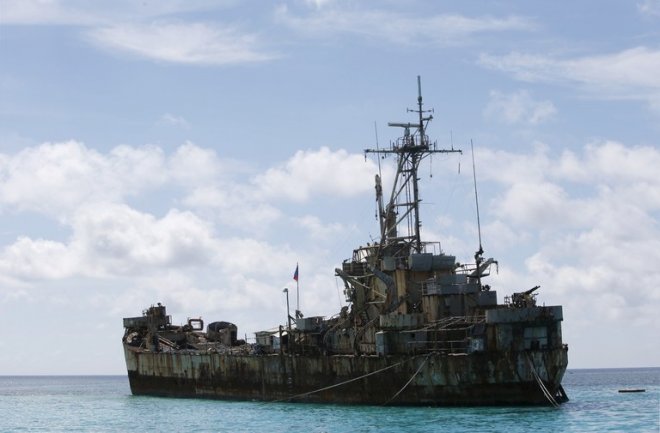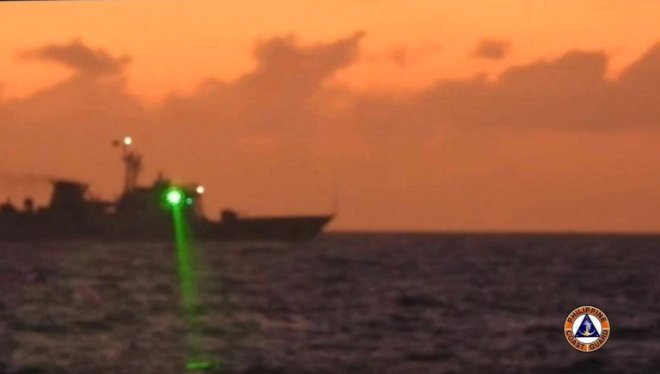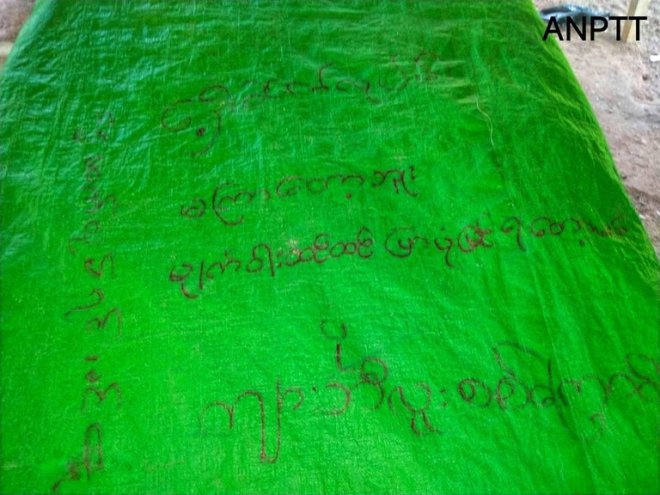Philippine Coast Guard says Chinese vessel blinded crew with laser
The Philippine Coast Guard on Monday accused China of performing dangerous maneuvers and pointing a laser at one of its vessels, causing temporary blindness to the crew.
Japan meanwhile said on Sunday a Chinese Navy ship intruded into its territorial waters for the first time since December. Territorial waters are the sea areas that lie within 12 nautical miles (22 kilometers) of a country"s coast.
RFA reported on Feb. 7 on the harassment of the BRP Malapascua by China Coast Guard (CCG) ship 5205 inside the Philippines’ exclusive economic zone (EEZ) a day earlier.
The Philippine Coast Guard (PCG) has now confirmed the incident, saying that the Malapascua at that time was supporting a rotation and resupply mission of the Philippine Navy in Ayungin Shoal (Second Thomas Shoal) in the West Philippine Sea.
The West Philippine Sea is the name usually used by the Philippines for the part of the South China Sea within the nation’s EEZ, where it holds exclusive rights to natural resources.
Military-grade laser
The PCG, in a statement sent to RFA affiliate BenarNews, said that the CCG vessel 5205 on Feb. 6 “directed a military-grade laser light” twice at the Philippine ship, “causing temporary blindness to her crew at the bridge.”
“The Chinese vessel also made dangerous maneuvers by approaching about 150 yards (137 meters) from the vessel"s starboard quarter,” the statement said.
The BRP Malapascua was just 10 nautical miles (18.5 kilometers) from the Second Thomas Shoal when it was harassed by the Chinese vessel and had to alter its course to continue its deployment.
![]() File photo showing the BRP Sierra Madre on the disputed Second Thomas Shoal, part of the Spratly Islands, in the South China Sea, March 29, 2014. Credit: Reuters/Erik De Castro
File photo showing the BRP Sierra Madre on the disputed Second Thomas Shoal, part of the Spratly Islands, in the South China Sea, March 29, 2014. Credit: Reuters/Erik De Castro
The Philippine ship was on a mission to deliver food and supplies to the troops stationed on the BRP Sierra Madre, an old naval ship deliberately run aground on the shoal to serve as a military post since 1999.
Another resupply mission last August by a different ship, the BRP Teresa Magbanua, was also obstructed by the Chinese Coast Guard, together with the Chinese maritime militia, according to the PCG statement.
“The deliberate blocking of the Philippine government ships to deliver food and supplies to our military personnel on board the BRP Sierra Madre is a blatant disregard for, and a clear violation of, Philippine sovereign rights in this part of the West Philippine Sea,” it said.
The PCG sent out two photos showing a green light being beamed from an alleged Chinese vessel.
“As far as I can recall, these are the first images available to the public that prove such behavior by the Chinese maritime forces at sea,” said Collin Koh, a Singapore-based military analyst.
“Regional authorities need to persistently gather such evidence and publicize them routinely to create international awareness,” Koh said.
Beijing has yet to respond to the Philippine Coast Guard’s accusation.
Military grade lasers are harmful and can cause blindness if shone into a person’s eyes. Pointing a laser at someone can also have a psychological impact, as laser targeting often happens right before a firing of live munitions.
![]() The Philippine Coast Guard said the laser beam had caused temporary blindness to the BRP Malapascua’s crew. Credit: Philippine Coast Guard
The Philippine Coast Guard said the laser beam had caused temporary blindness to the BRP Malapascua’s crew. Credit: Philippine Coast Guard
This is not the first time China has been accused of pointing laser lights at foreign aircraft and vessels.
A year ago, on Feb. 17, 2022, Australia said a Chinese navy ship pointed a laser at one of its surveillance airplanes in the Arafura Sea within Australia’s EEZ.
In Feb. 2020, a Chinese military warship reportedly trained a laser on a U.S. Navy P-8 surveillance aircraft while it was flying over the Pacific Ocean. The Chinese government denied the accusation, saying the P-8 was flying too low near its warships despite warnings.
In 2019, Australian navy helicopter pilots taking part in the Indo-Pacific Endeavour 2019 military exercise in the South China Sea said they were hit with laser beams from fishing boats suspected of being part of China’s maritime militia.
Japan’s security concerns
In another development, Japan accused China of encroaching upon its sovereignty, causing “security concerns.”
“On February 12, it was confirmed that a Chinese Navy Shupang-class survey ship sailed through Japan’s territorial waters near Yakushima Island,” the Japanese Defense Ministry said.
The Chinese ship was first spotted at around 12:50 a.m. on Sunday south of the island of Yakushima.
It entered Japan"s territorial waters southwest of the island at around 2:30 a.m. and sailed there for about an hour and 40 minutes, the ministry said.
“This is the 10th time, the first since December last year, that we announce Chinese Naval vessel’s entry into Japan’s territorial waters,” it said, adding that “these Chinese naval activities are of national security concern.”
Since December, after Tokyo designated Beijing an unprecedented “strategic challenge” in its latest National Security Strategy, China has stepped up patrols around Japan, especially near the Senkaku islands which are under Tokyo’s control but also claimed by Beijing.
On Sunday, Philippines President Ferdinand R. Marcos Jr. concluded his four-day official visit to Japan.
Marcos told Philippine media that he was open to the idea of a Visiting Forces Agreement (VFA) with Japan as long as the deal is “appropriate" and does not increase tensions” in the South China Sea.
Before that, the president said Manila will consider a proposed trilateral defense and security deal with the United States and Japan.
BenarNews staff in Manila contributed to this report.
BenarNews is an RFA-affiliated news organization.
[圖擷取自網路,如有疑問請私訊]
Japan meanwhile said on Sunday a Chinese Navy ship intruded into its territorial waters for the first time since December. Territorial waters are the sea areas that lie within 12 nautical miles (22 kilometers) of a country"s coast.
RFA reported on Feb. 7 on the harassment of the BRP Malapascua by China Coast Guard (CCG) ship 5205 inside the Philippines’ exclusive economic zone (EEZ) a day earlier.
The Philippine Coast Guard (PCG) has now confirmed the incident, saying that the Malapascua at that time was supporting a rotation and resupply mission of the Philippine Navy in Ayungin Shoal (Second Thomas Shoal) in the West Philippine Sea.
The West Philippine Sea is the name usually used by the Philippines for the part of the South China Sea within the nation’s EEZ, where it holds exclusive rights to natural resources.
Military-grade laser
The PCG, in a statement sent to RFA affiliate BenarNews, said that the CCG vessel 5205 on Feb. 6 “directed a military-grade laser light” twice at the Philippine ship, “causing temporary blindness to her crew at the bridge.”
“The Chinese vessel also made dangerous maneuvers by approaching about 150 yards (137 meters) from the vessel"s starboard quarter,” the statement said.
The BRP Malapascua was just 10 nautical miles (18.5 kilometers) from the Second Thomas Shoal when it was harassed by the Chinese vessel and had to alter its course to continue its deployment.
 File photo showing the BRP Sierra Madre on the disputed Second Thomas Shoal, part of the Spratly Islands, in the South China Sea, March 29, 2014. Credit: Reuters/Erik De Castro
File photo showing the BRP Sierra Madre on the disputed Second Thomas Shoal, part of the Spratly Islands, in the South China Sea, March 29, 2014. Credit: Reuters/Erik De CastroThe Philippine ship was on a mission to deliver food and supplies to the troops stationed on the BRP Sierra Madre, an old naval ship deliberately run aground on the shoal to serve as a military post since 1999.
Another resupply mission last August by a different ship, the BRP Teresa Magbanua, was also obstructed by the Chinese Coast Guard, together with the Chinese maritime militia, according to the PCG statement.
“The deliberate blocking of the Philippine government ships to deliver food and supplies to our military personnel on board the BRP Sierra Madre is a blatant disregard for, and a clear violation of, Philippine sovereign rights in this part of the West Philippine Sea,” it said.
The PCG sent out two photos showing a green light being beamed from an alleged Chinese vessel.
“As far as I can recall, these are the first images available to the public that prove such behavior by the Chinese maritime forces at sea,” said Collin Koh, a Singapore-based military analyst.
“Regional authorities need to persistently gather such evidence and publicize them routinely to create international awareness,” Koh said.
Beijing has yet to respond to the Philippine Coast Guard’s accusation.
Military grade lasers are harmful and can cause blindness if shone into a person’s eyes. Pointing a laser at someone can also have a psychological impact, as laser targeting often happens right before a firing of live munitions.
 The Philippine Coast Guard said the laser beam had caused temporary blindness to the BRP Malapascua’s crew. Credit: Philippine Coast Guard
The Philippine Coast Guard said the laser beam had caused temporary blindness to the BRP Malapascua’s crew. Credit: Philippine Coast GuardThis is not the first time China has been accused of pointing laser lights at foreign aircraft and vessels.
A year ago, on Feb. 17, 2022, Australia said a Chinese navy ship pointed a laser at one of its surveillance airplanes in the Arafura Sea within Australia’s EEZ.
In Feb. 2020, a Chinese military warship reportedly trained a laser on a U.S. Navy P-8 surveillance aircraft while it was flying over the Pacific Ocean. The Chinese government denied the accusation, saying the P-8 was flying too low near its warships despite warnings.
In 2019, Australian navy helicopter pilots taking part in the Indo-Pacific Endeavour 2019 military exercise in the South China Sea said they were hit with laser beams from fishing boats suspected of being part of China’s maritime militia.
Japan’s security concerns
In another development, Japan accused China of encroaching upon its sovereignty, causing “security concerns.”
“On February 12, it was confirmed that a Chinese Navy Shupang-class survey ship sailed through Japan’s territorial waters near Yakushima Island,” the Japanese Defense Ministry said.
The Chinese ship was first spotted at around 12:50 a.m. on Sunday south of the island of Yakushima.
It entered Japan"s territorial waters southwest of the island at around 2:30 a.m. and sailed there for about an hour and 40 minutes, the ministry said.
“This is the 10th time, the first since December last year, that we announce Chinese Naval vessel’s entry into Japan’s territorial waters,” it said, adding that “these Chinese naval activities are of national security concern.”
Since December, after Tokyo designated Beijing an unprecedented “strategic challenge” in its latest National Security Strategy, China has stepped up patrols around Japan, especially near the Senkaku islands which are under Tokyo’s control but also claimed by Beijing.
On Sunday, Philippines President Ferdinand R. Marcos Jr. concluded his four-day official visit to Japan.
Marcos told Philippine media that he was open to the idea of a Visiting Forces Agreement (VFA) with Japan as long as the deal is “appropriate" and does not increase tensions” in the South China Sea.
Before that, the president said Manila will consider a proposed trilateral defense and security deal with the United States and Japan.
BenarNews staff in Manila contributed to this report.
BenarNews is an RFA-affiliated news organization.
[圖擷取自網路,如有疑問請私訊]
|
本篇 |
不想錯過? 請追蹤FB專頁! |
| 喜歡這篇嗎?快分享吧! |
相關文章
AsianNewsCast


















